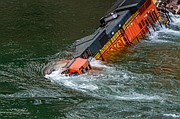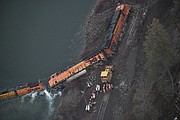Rockslide causes BNSF train to derail into the Kootenai River
MOYIE SPRINGS — A rockslide caused the derailment of a mile-long BNSF Railway train that was en route from Minneapolis, Minn., to Pasco, Wash., on Wednesday night, Jan. 1, sending an engine with its two-person crew plunging into the Kootenai River.
The crew — a conductor and an engineer from the Spokane/North Idaho area — were not injured, said Gus Melonas, director of public affairs for BNSF Railway for the region.
“The crew is fine, they’re good,” he added Thursday.
Various personnel responded within minutes of the derailment, which was reported at 8:45 p.m.
“For an incident like this, we had tremendous support from all the first responders and everyone involved,” Kramer said. “We really appreciate Two Bear Air being there. As it turns out, we were able to rescue the employees with the Sheriff’s boat, but Two Bear was there as backup. Everything came together well.”
Kramer praised Marine 1, the Boundary County Sheriff’s boat crew and dispatchers, which brought additional staff on board to help during the emergency. Making the response even more notable is the remoteness and difficult terrain.
“It is a challenge going up that part of the river, even in the daylight, with the low waters and sandbars that need to be negotiated,” he said. “Despite the conditions, they did a great job. This shows our community how many first responders turned out from just about every agency to bring this to a successful resolution.”
Rescue crews, including a BNSF employee who responded to the scene, found the conductor and the engineer on the engine. A first responder said the BNSF employee smashed one of the windows on the train to get the trapped employees out and on top of the train. A medic and a firefighter showed up in a high rail truck with life jackets and helmets for the train crew.
About the same time, the BCSO boat arrived on scene, tied up to the lead engine and were able to rescue the stranded employees.
South Boundary Fire Chief Tony Rohrwasser praised the rescue operation and the coordinated response.
“It was well put together,” he said. “They did a great job with both command and operation. All of the different agencies worked well together.“
As various crews responded, North Bench Fire Chief Gus Jackson established a command center in the Riverside area, which then was transitioned into a unified command between the multiple responding agencies.
“It was a very in-depth and complex scenario with multiple resources,” Jackson said.
While Two Bear Air Rescue out of Flathead County, Mont., responded to the scene, they ended up not being needed to pull the crew from the partially submerged locomotive.
“They flew through very bad weather, which was awesome of them,” Jackson said. “I think it was fantastic despite all of the challenges and risks involved with it being on the water and at night.”
Because of the coordinated response and training, Boundary County officials said the result was as positive an outcome as possible given the circumstances.
“We were able to safely prevent loss of life, rescue the crew members, and prevent further environmental damage,” Jackson said.
BNSF crews removed fuel from the locomotive on the bank and booms were deployed downstream to contain any diesel that leaked from the lead locomotive.
Two of the locomotives — one which ended up on the riverbank and another that ended up in the right of way — were re-railed Friday with cranes and crews brought in to do the work. On Saturday, around 1 p.m., the line is now open to traffic.
While a plan is still being developed to remove the locomotive in the Kootenai River, the second locomotive derailed by a landslide last week should be re-railed early next week, railroad officials said.
Gus Melonas, director of public affairs for BNSF Railway for the region, said equipment is being positioned to bring the locomotive on the river bank back on track Monday. The locomotive would then be moved to Crossport for further mechanical inspection and repair before being sent to a major shop location for necessary overhaul.
A plan is still being developed, in coordination with the appropriate agencies, for the locomotive in the river, Melonas said.
“We’re working with agencies to ensure overall safety environmental protection,” he said. “It appears that the plan at this point is to move the locomotive that’s in the water to the north shore, so across the water from the railroad tracks. It would be disposed of at that location.”
“We’re still developing a plan at this point, which could include scrapping it.”
A timeline on the train’s removal is still being developed, Melonas said.
“For overall safety and environmental protection, a final timeline on its removal has not been determined,” he added.
Melonas said about 1,900 gallons of diesel were in the submerged locomotive. Crews are assessing what remains in the locomotive and a plan is being developed for its removal. Booms have been installed downriver of the accident site and Melonas said the railroad is working closely with the various agencies to protect the environment and taking the necessary steps to work through the process.
Of the six cars that derailed, Melonas said five were empty and the sixth contained a steel product. That car was unloaded and then re-railed. The train, which measured over a mile in length, had 115 cars — 74 of which were empty and 41 which contained freight.
Geo-technicians were dispatched to the site and determined the rockslide was 50 feet wide with a debris field 10 feet deep. It is unclear what caused the slide, BNSF officials said.









